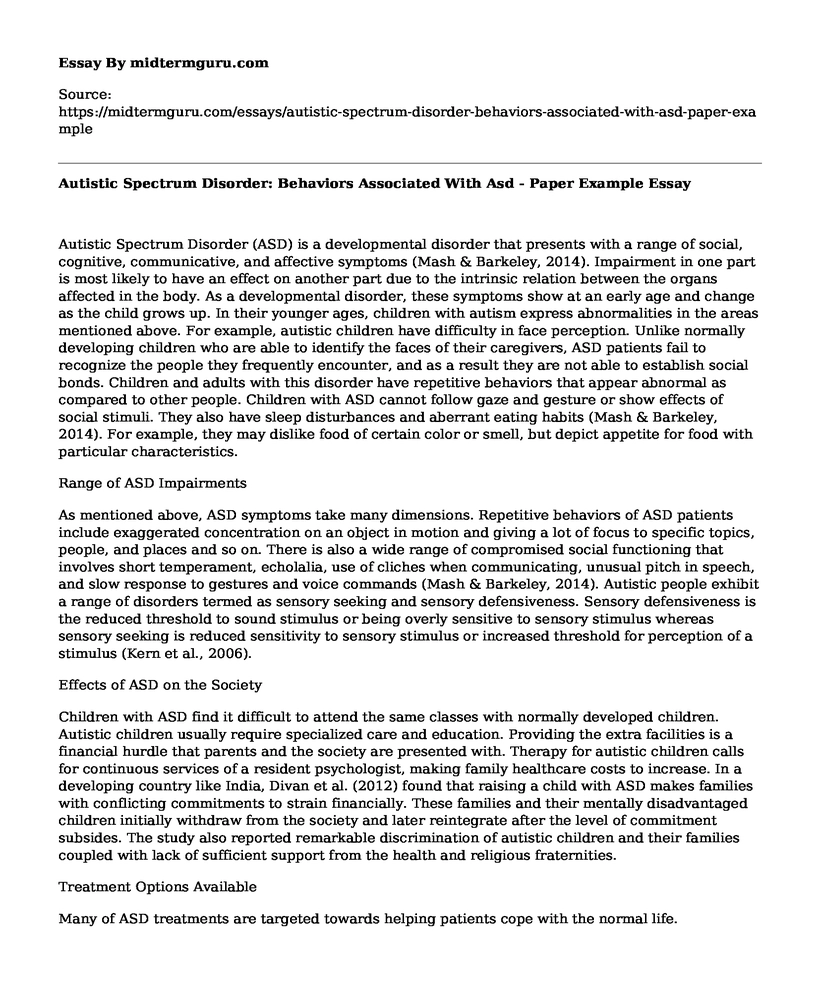Autistic Spectrum Disorder (ASD) is a developmental disorder that presents with a range of social, cognitive, communicative, and affective symptoms (Mash & Barkeley, 2014). Impairment in one part is most likely to have an effect on another part due to the intrinsic relation between the organs affected in the body. As a developmental disorder, these symptoms show at an early age and change as the child grows up. In their younger ages, children with autism express abnormalities in the areas mentioned above. For example, autistic children have difficulty in face perception. Unlike normally developing children who are able to identify the faces of their caregivers, ASD patients fail to recognize the people they frequently encounter, and as a result they are not able to establish social bonds. Children and adults with this disorder have repetitive behaviors that appear abnormal as compared to other people. Children with ASD cannot follow gaze and gesture or show effects of social stimuli. They also have sleep disturbances and aberrant eating habits (Mash & Barkeley, 2014). For example, they may dislike food of certain color or smell, but depict appetite for food with particular characteristics.
Range of ASD Impairments
As mentioned above, ASD symptoms take many dimensions. Repetitive behaviors of ASD patients include exaggerated concentration on an object in motion and giving a lot of focus to specific topics, people, and places and so on. There is also a wide range of compromised social functioning that involves short temperament, echolalia, use of cliches when communicating, unusual pitch in speech, and slow response to gestures and voice commands (Mash & Barkeley, 2014). Autistic people exhibit a range of disorders termed as sensory seeking and sensory defensiveness. Sensory defensiveness is the reduced threshold to sound stimulus or being overly sensitive to sensory stimulus whereas sensory seeking is reduced sensitivity to sensory stimulus or increased threshold for perception of a stimulus (Kern et al., 2006).
Effects of ASD on the Society
Children with ASD find it difficult to attend the same classes with normally developed children. Autistic children usually require specialized care and education. Providing the extra facilities is a financial hurdle that parents and the society are presented with. Therapy for autistic children calls for continuous services of a resident psychologist, making family healthcare costs to increase. In a developing country like India, Divan et al. (2012) found that raising a child with ASD makes families with conflicting commitments to strain financially. These families and their mentally disadvantaged children initially withdraw from the society and later reintegrate after the level of commitment subsides. The study also reported remarkable discrimination of autistic children and their families coupled with lack of sufficient support from the health and religious fraternities.
Treatment Options Available
Many of ASD treatments are targeted towards helping patients cope with the normal life. Communication, academic and social interaction skills help patients to improve on the respective impairments. There are various chemical treatments available, although each one of them addresses a particular symptom associated with ASD. Behavioral therapy is commonly used in the treatment process. A comparison of Pivotal Response Treatment and Applied Behavioral Analysis showed that the former approach is more effective of the two when used for both targeted and untargeted treatment (Mohammadzaheri et al, 2012).
References
Divan, G., Vajaratkar, V., Desai, M. U., StrikLievers, L., & Patel, V. (2012). Challenges, coping strategies, and unmet needs of families with a child with autism spectrum disorder in Goa, India. Autism Research, 5(3), 190-200
Kern, J. K., Trivedi, M. H., Garver, C. R., Grannemann, B. D., Andrews, A. A., Savla, J. S., ... & Schroeder, J. L. (2006). The pattern of sensory processing abnormalities in autism. Autism, 10(5), 480-494.
Mash, E. J., & Barkley, R. A. (Eds.). (2014). Child psychopathology. Guilford Publications.Mohammadzaheri, F., Koegel, L. K., Rezaee, M., & Rafiee, S. M. (2014). A randomized clinical trial comparison between pivotal response treatment (PRT) and structured applied behavior analysis (ABA) intervention for children with autism. Journal of autism and developmental disorders, 44(11), 2769-2777.
Cite this page
Autistic Spectrum Disorder: Behaviors Associated With Asd - Paper Example. (2021, May 27). Retrieved from https://midtermguru.com/essays/autistic-spectrum-disorder-behaviors-associated-with-asd-paper-example
If you are the original author of this essay and no longer wish to have it published on the midtermguru.com website, please click below to request its removal:
- Essay on Nurses Practice Dilemmas Acts and Regulations
- Paper Example on Nutrition
- Article Analysis Essay on Effects of Prenatal Music Exposure
- Curbing the Opioid Crisis: Crafting Legislation to Prevent Abuse - Research Paper
- Asthma: A Global Health Threat Affecting 300 Million People - Research Paper
- Nurse's Role in Countering Measles Epidemic - Essay Sample
- Trustworthy Information in a Digital Age: Analyzing Sources & Discrediting Fake News - Research Paper







